VINTAGE WW1 BRITISH BOER WAR SERVICE MEDAL TO MYCOCK! HQ DIVISION SAC 5 BAR QSA
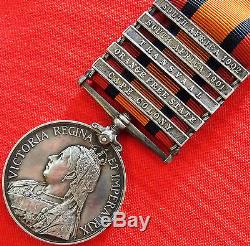
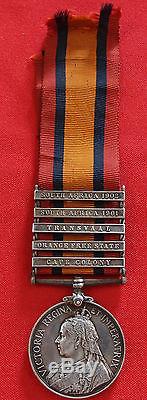
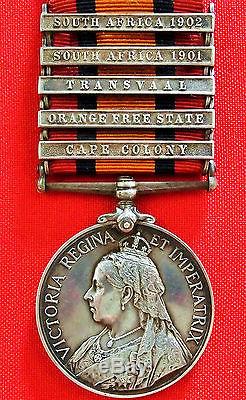
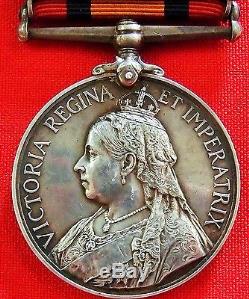
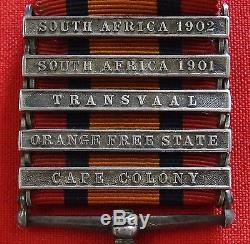
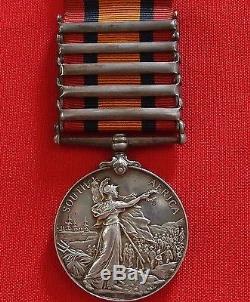
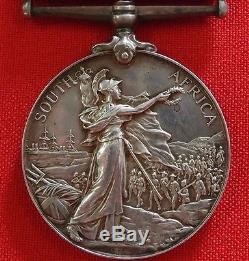
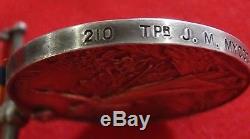
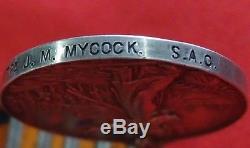
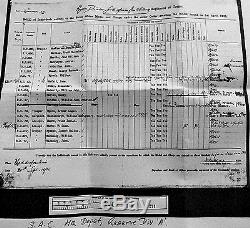

Offered is a Boer War Queen's South Africa Medal, as awarded to Trooper Joseph Malins Mycock, who served with Headquarters, Division'A' of the South African Constabulary during the Boer War. Queen's South Africa Medal with 5 campaign bars, CAPE COLONY, ORANGE FREE STATE, TRANSVAAL, SOUTH AFRICA 1901 & SOUTH AFRICA 1902. Correclty named to: 210 TPR J. The medal retains the origina; old ribbon, full length and the medal is still toned. Mycock bet he copped it from his mates!
Is confirmed on the roll for the medal. It is his full entitlement and copy of roll comes with the medal. In September 1900 Lord Roberts instructed Major General R S Baden-Powell, CB, to draw up a scheme for a Constabulary Force for the Transvaal (including Swaziland and Orange River Colonies) to be ready for work by June 1901, under the orders of Lord Milner as High Commissioner. At that time it was thought that the country was about to settle down to a peace, and it was considered that for normal peace times a force of 6 000 Officers, Non-Commissioned Officers and men might suffice. In view of the probable early restoration of peace and withdrawal of part of the Military Forces, the Commander-in-Chief agreed to hand over the new Force proportion of Officers, Non-Commissioned Officers and Men to 20 per cent of each Corps to form it with Horses, Saddlery, Arms, Transport, etc. As required, and to furnish it with medical treatment through the Army Hospitals. Of October 1900, Lord Roberts issued a Proclamation, known as Proclamation 24, under which the South African Constabulary was raised and has worked ever since. The Force was first organised in four Divisions, each commanded by a Colonel, assisted by a Staff. There were 3 divisions in the Transvaal, and one division in the Orange River Colony. Each division was sub-divided into Troops of 100 men, each under the command of a Captain and Lieutenant. As hostilities showed no signs of ceasing, it was gradually found that the Army were unable to carry out the agreement proposed by the Commander-in Chief, and consequently the Inspector-General (Major-General Baden-Powell) was obliged to establish Recruiting Offices in Cape Colony and Natal, and to arrange for recruits from overseas, both from England and Canada.In addition, arrangements had to be made for obtaining remounts in South Africa, Australia, North America etc. Arrangements also had to be made for obtaining Transport, Equipment, Saddlery, etc.
And finally, the Army being unable to meet the Forces medical, vetenary, and building requirements. Medical, Vetenary and Works Departments had to be organised. In December 1900, it was decided that the establishment should be further increased to 10 000 men. In 1901, in addition to the other Division, a Reserve Division was raised. 9 Officers and 85 men were killed in action or died from wounds, and 213 Officers and Men were wounded, whilst 274 Officers and Men died from sickness.
Very shortly after the termination of the War, orders were issued for the various Troops to take up with all possible speed their distribution over the whole face of the two new Colonies. The organisation of the Force enabled this distribution to be carried out without any difficulty or delay, and a Troop and a self-contained Unit of 100 men was sent to occupy each Sub-District, its Headquarters acting as a support and supply depot to its several small outstations, which were then dotted about the surrounding country. In this way a network of Posts and Patrols was established in a very short space of time, in such a manner as to ensure every farm was visited once a week. The furthest boundaries of the country were regularly patrolled in every direction, including the Portuguese and Tongaland Frontiers. By the beginning of August 1902, 28 Districts, 64 Sub-Districts and 210 Stations were occupied.
The immediate effect of this was to bring the Natives into a state of order, and to enable the repatriation of the Burghers to proceed without delay or danger to them. Property was protected and assistance given to the Burghers requiring it. In this way the relations between the Burghers and the Constabulary started on a very satisfactory footing.The Native Commissioners, after explaining the new regime to the various tribes, were enabled to carry out the disarmament of the Natives throughout the country. In November 1902, peace was so far secured and promised for the future, that it was considered advisable to reduce the Force to its normal peace establishment of 6 000 men.
A re-organisation of the Force now became necessary, and although the Divisions were retained, the Troops as a Unit was abolished, and each Division organised accordingly to the Magisterial Districts. Each District was allocated a certain number of men, and were sub-divided into Sub-Districts and Posts. A few Mobile Troops were retained as a Reserve ready for service at any moment on emergency. The following extract from the report of the South African Constabulary Commission of 1905 will perhaps give sufficient record.
On the termination of the War, the Constabulary were the only Department which extended its sphere of action to extent any extent throughout the two Colonies, and instructions were given that they were to be of general assistance to everyone in getting things in order towards the settling down of the Country, not merely to Government Departments. At the meeting of the Inter-Colonial Council held in June 1905, it was resolved to appoint a Commission to enquire into the administration and organisation of the Force.As a result of the Commission, the Force, from the 1. July 1906, was organised into 2 Divisions, viz, the Transvaal and the Orange River Colony, so far as regards Police work. In addition, a Depot was continued in each Colony, and 5 Mobile Columns were retained as a Reserve. The titles of Officers were altered from a Military character to that of a purely Police character; for instance Captains became Inspectors; and Lieutenants became Sub-Inspectors; but owing to the provisions of the Proclamation under which the Force was formed, it was necessary, in dealing with discipline, to retain the Military titles, but for all other matters the Police titles were adopted. The re-organisation of the Force was carried out without difficulty, as the various Divisions in the Transvaal had previously abolished, viz.
Eastern Transvaal Division, from 1. Western Transvaal Division from 1. Northern Transvaal Division from1st October 1905. Medical, Veterinary, and Work Departments were abolished.
Stood at a strength of 1 742 Europeans, of which 1 068 are in the Transvaal and 674 in the Orange River Colony. The Swaziland District was abolished as a unit of the South African Constabulary from the 1. Of April 1907 and a local police force substituted. Please view our guide on spotting fake militaria. We list militaria and coins weekly.
JB Military Antiques - We provide quality mounted medals, badges and historical research. We can also conduct military research on your behalf and value cherished objects with a current market or insured value.
2/135 Russell St, Morley, WA. Items are accurately described & photographed. Additional costs for this standard service will be added for this service based on publicly available Australia Post rates. Please note, these items are located and will be posted from Australia. We appreciate fair feedback from you once you receive the item.We aim to give you, the customer our best customer service. The item "VINTAGE WW1 BRITISH BOER WAR SERVICE MEDAL TO MYCOCK! HQ DIVISION SAC 5 BAR QSA" is in sale since Friday, April 15, 2016.
This item is in the category "Collectables\Militaria\1914 - 1918 (WWI)". The seller is "jb_military_antiques_14" and is located in 2/135 Russell St, Morley, Perth, WA. This item can be shipped worldwide.- Authenticity: Original
- Country: UK
- Campaign: WW1
- Product Type: Medals
- Era: 1900s

